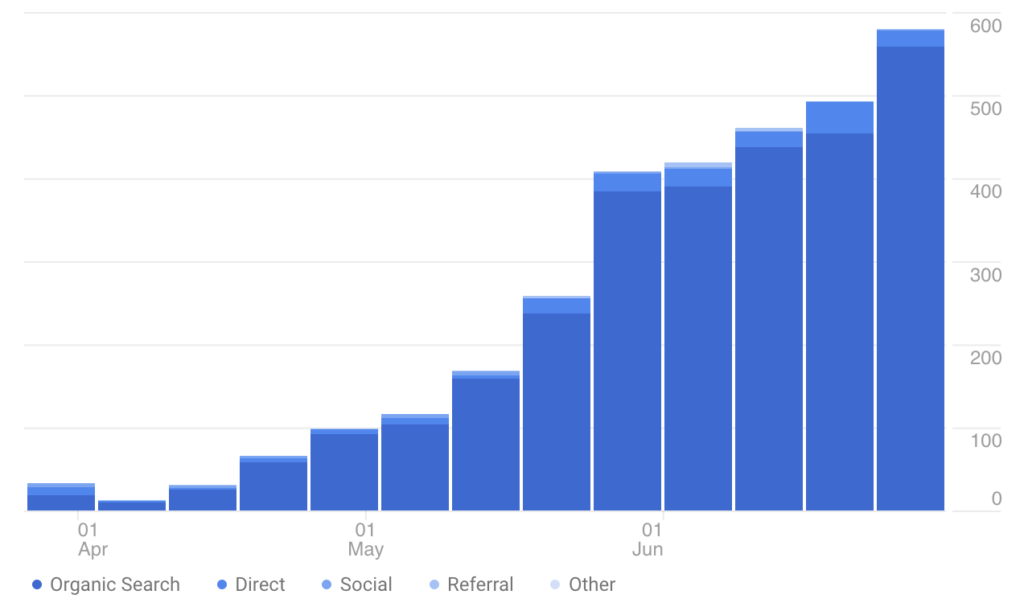Depending on the industry, a new SEO content marketing campaign can take 3-6 months to start seeing results. The good news? Once the results start rolling in… they keep rolling and rolling in.
In this case study, I’ll go over exactly how I increased one website’s organic visitors by 42,375% over the course of just 4 months. As of this writing, the numbers keep going up.
I got these results by writing just 1-2 high-quality, keyword-optimized blog posts each month, starting mid-February. By June, this website had published 6 blog posts total, up from zero.



No backlinks. No social media campaigns. No advertising. Just good content.
This website is now converting its bloom of organic visitors into sales.
Check out this additional case study I did for one of my law firm clients. You can also click here for answers to the most frequently asked questions about content marketing for lawyers.
Case Study with Google Analytics: SEO Performance
Let’s put our subject website into a little more context.
This is a hobby-based website that covers two different topics with little overlap. One topic is high volume and high competition. The other topic is mid-volume, mid-competition.


The 6 blog posts published during this time were in-depth articles between 1,000 – 2,500 words long, with targeted keywords and SEO-friendly formatting.

By almost every metric, this SEO campaign is a resounding and continuing success.
- The total number of pageviews went up by 2,874%.
- The total number of individual visitors (users) went up by 3,680%.
- The average session duration went up by 27% to just over 2 minutes.
What’s even better about SEO is that it builds on itself over time. So whenever this website publishes any new content, we can create internal links between the established pages to the new ones. This immediately sets a route for Google and visitors to follow, and the faster the new page ranks.
Let’s take a look at the metrics that didn’t do so great. How can we improve them?
- The number of sessions per user went down by about 5%, which isn’t huge. This means slightly fewer people returned to the website as repeat users.
- Pages per session went down by 17%, which means people browsed fewer pages on the website whenever they visited. This could be fixed with: 1) better internal linking between pages, and 2) publishing more related pages for people to browse on the website.
- The bounce rate went up by 13%. (I discuss bounce rate in this video if you need a refresher.) This can be remedied with the same solutions as above.
This is what makes Google Analytics so powerful. You can see what content is performing the best and what areas need improvement. Your website’s performance data allows you to make informed decisions when it comes to your content marketing strategy.
The plan moving forward is to do more of the same. Put out highly relevant, high-quality, keyword-rich content with great headlines to get more clicks and longer visits.
How to Optimize Your Content for SEO
SEO is not a stab in the dark. No marketing should be – not when dollars are on the line. Keyword research is a part of the market research process.
Search engine optimization is all about finding keywords that people actually use to search for your services or products. This is the basic breakdown:
- Think of what someone might actually type into Google if they were searching for your product or service. When I say keywords, I’m not talking about your company name or brand. Think about the reasons someone might buy from you or need your services. What questions might someone ask? Click here to read more about effective keyword-researching strategies.
- Look at Google’s public keyword data to find out which keywords get the most traffic per month and which are the most competitive.
- Pick a primary keyword to target – this will be the focus of your page. It should show up in your page title and several times throughout the text.
- Include related secondary keywords in your content – as many as you can, just make sure the writing sounds natural. (Avoid keyword stuffing!)
- And finally, this step is the hardest and has no shortcut: write good content!
SEO is all about the long game. Whatever quality content you create will continue to build your website’s authority and reputation over time.
Don’t get caught in the SEO marketing trap of following every little change to Google’s search algorithms. On that note, don’t listen to SEO marketers who swear by their ability to game the algorithm, either. Cheating Google’s search engine algorithm will rarely work and even if it does, Google will probably figure out you’re doing something shady and penalize your rankings for it.
The truth is, no matter how many times Google changes its algorithm, high-quality, relevant content will always do well. So just keep creating high-quality, relevant content. (Or better yet, hire a professional writer with a track record of results to do it for you.) Make your content informational, useful, approachable, and readable. This solid practice will never go out of style.
Want to discuss your SEO or content marketing strategy? Do you have questions about your Google Analytics reports? Email me or use this contact form to get in touch.
